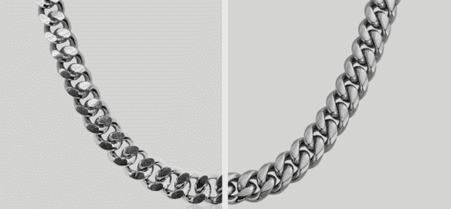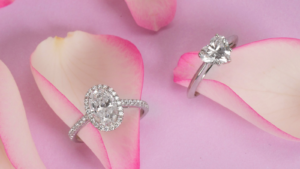If you have bought a silver necklace, you must have been shown the tag of 925 sterling silver or normal silver. They look the same from the outside, but quality, longevity, and even the cost can really be quite different. It is natural to assume that anything that is silver must be the same, but sorry to say it’s not so. How well something is built with silver may or may not keep your necklace long-lasting, if it tarnishes too quickly or not, and even if it makes you break out or not.
We will be discussing all the things that you should be aware of regarding plain silver and sterling ones in silver necklaces for women, so that you can make an informed decision when choosing a new addition to your collection.
Know Silver in Jewelry
Silver has been among the most precious metals on the planet for centuries already. Its own natural luster, ductility, and richness make it a sought-after product for jewelry as a whole and necklaces in specific. Not all that is silver, though, is pure silver. Pure silver is not typically used to make necklaces because it is too malleable and too soft. It is thus sometimes mixed with other metals in an effort to strengthen and toughen it and thus create a series of various silver alloys.
Most jewelers and manufacturers are fraudulent with their application of such words as “silver,” which is deceptive to the customer. Some of them aresterling silver necklaces, some are silver plated, and some are made out of a metal painted silver and completely unrelated to the real thing.
What is 925 Sterling Silver?
925 sterling silver is the best combination of silver utilized in jewelry. It contains 92.5% pure silver and 7.5% any other metal, ideally copper. Combined, they render sterling silver far more resilient than pure silver without diminishing its natural luster. A mark of 925 on necklaces produced by sterling silver guarantees and guarantees the product’s quality to the same extent industries set standards for it.
One of the most widespread uses of alloying sterling silver with copper is hardening. Silver by itself is very soft and will scratch or bend easily. When jewelers alloy a small amount of copper with it, they can make a hard metal that can be worn on the body without losing the beautiful, mirrored appearance that silver has to offer.
While the sterling silver will tarnish, don’t worry. Tarnish is caused by the silver oxidizing when it’s exposed to air and moisture in an attempt to create a protective oxidation coating. The good news is that the tarnish can be easily cleaned away by using a polishing cloth or a silver cleaner and your necklace is new again.
A second major advantage of 925 sterling silver is that it’s hypoallergenic. Though cheaper metals made of nickel or other allergens will irritate your skin and shouldn’t be worn by those who are sensitive, sterling silver is safe for anyone to wear, even people with sensitive skin. This makes a wonderful option for jewelry to wear every day, especially necklaces that have contact with your skin.
What is Regular Silver?
Common silver is a term that can be used to describe any type of mixed silver or silver-colored metal that is plated into jewelry. The term is not regulated, so normal silver jewelry can range from silver-plated to an amalgam with very little actual silver content. It’s where the consumer has to beware because all silver-appearing does not have wondrous silver.
One of the more widespread types of home silver are silver-plated items. These are pieces of jewelry that possess an adherent layer of silver attached to a base metal such as brass or copper. Although they may appear quite similar to sterling silver when new, the silver plating will wear off with time to expose the cheaper metal underneath. This is to mean that silver-plated necklaces are not durable and will tarnish quicker than sterling silver.
Another everyday silver is nickel silver, or German silver. While it is named silver, it is not an alloy made of any silver. It is usually an alloy of nickel, copper, and zinc employed to duplicate the look of silver at a significantly lower cost. While a less expensive substitute, nickel silver is infamous for causing skin irritation and allergic reactions, especially in sensitive skin.
Plain silver, on the other hand, can literally be nothing more than an unspecified silver alloy of indeterminate content. While sterling silver is at least 92.5% silver, less costly alloys are an unspecified percentage of silver combined with other metals. When not specified, there is no telling exactly how much actual silver you are receiving in the product you buy.
Major Differences Between 925 Sterling Silver and Pure Silver
The greatest difference between regular silver and sterling silver is in the proportion of silver. Sterling silver contains 92.5% pure silver, but not regular silver. The difference is enormous, when it comes to durability, longevity, and worth.
Sterling silver is harder and less prone to damage than cheaper silver alloys or silver plates. With good care, it will be durable for generations and thus it’s an investment one has to make for jewelry lovers. Regular silver, especially silver-plated ones, however, will lose its shine, tarnish, or get damaged quickly.
The second significant difference is the way in which the metal interacts with skin. Sterling silver should be okay with sensitive skin, yet nickel silver or poorly constructed silver-plated items may bring about rashes, itchiness, or discoloration. If your skin went greenish or darkened following the use of a silver necklace, it is likely that it was low-quality alloy and not proper sterling silver.
Price also comes into consideration. Sterling silver will cost a little more than silver but will also wear out less rapidly. If you calculate you will be wearing your necklace for years at a time, then sterling silver is the way to go.
How to Identify Real 925 Sterling Silver
If you’re willing to ensure that you are purchasing the original one, always ensure there is 925 hallmarks on the necklace. It is the hallmark which shows the product contains 92.5% sterling silver. If any component is marked as “silver” and does not have a hallmark, then it can be imitation sterling silver.
Another quick test to see whether your silver necklace is genuine is the magnet test. Sterling silver does not possess a magnetic character, and hence, if your necklace sticks to a magnet, then most probably it isn’t made of actual silver. The rub test is simple as well—rub the necklace over a white cloth softly. Black spots emerging on the cloth show that the object is oxidizing, i.e., that it’s genuine silver.
You can also use the ice test since silver is an effective heat conductor. Place an ice cube in your silver chain and it will melt faster compared to placing it on other than silver materials. It is easy for you to conduct a home test.
In deciding between 925 sterling silver and common silver, one should take into account cost, longevity, and quality. While common silver jewelry, as well as plated jewelry, is low in cost, they are less durable and smudge their shine instantly.
So the next time you shop to buy a silver necklace, take a good look. A true sterling silver item is money well spent—both to look at and for how long.”.





Be First to Comment